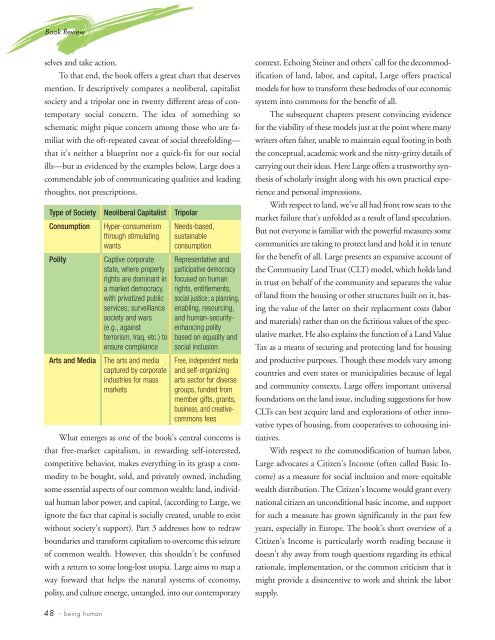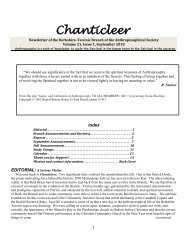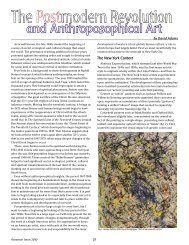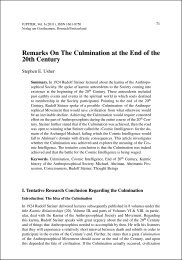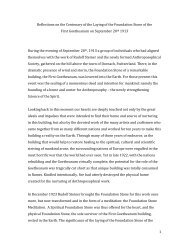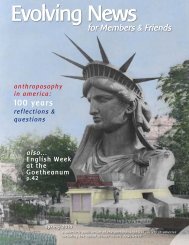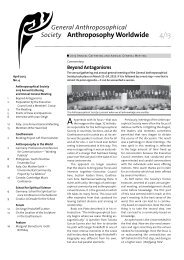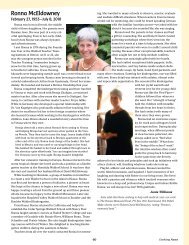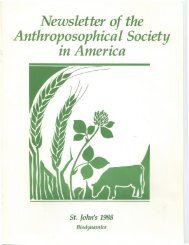Rudolf Steiner's Vision for the Future - Anthroposophical Society in ...
Rudolf Steiner's Vision for the Future - Anthroposophical Society in ...
Rudolf Steiner's Vision for the Future - Anthroposophical Society in ...
Create successful ePaper yourself
Turn your PDF publications into a flip-book with our unique Google optimized e-Paper software.
Book Review<br />
selves and take action.<br />
To that end, <strong>the</strong> book offers a great chart that deserves<br />
mention. It descriptively compares a neoliberal, capitalist<br />
society and a tripolar one <strong>in</strong> twenty different areas of contemporary<br />
social concern. The idea of someth<strong>in</strong>g so<br />
schematic might pique concern among those who are familiar<br />
with <strong>the</strong> oft-repeated caveat of social threefold<strong>in</strong>g—<br />
that it’s nei<strong>the</strong>r a bluepr<strong>in</strong>t nor a quick-fix <strong>for</strong> our social<br />
ills—but as evidenced by <strong>the</strong> examples below, Large does a<br />
commendable job of communicat<strong>in</strong>g qualities and lead<strong>in</strong>g<br />
thoughts, not prescriptions.<br />
What emerges as one of <strong>the</strong> book’s central concerns is<br />
that free-market capitalism, <strong>in</strong> reward<strong>in</strong>g self-<strong>in</strong>terested,<br />
competitive behavior, makes everyth<strong>in</strong>g <strong>in</strong> its grasp a commodity<br />
to be bought, sold, and privately owned, <strong>in</strong>clud<strong>in</strong>g<br />
some essential aspects of our common wealth: land, <strong>in</strong>dividual<br />
human labor power, and capital, (accord<strong>in</strong>g to Large, we<br />
ignore <strong>the</strong> fact that capital is socially created, unable to exist<br />
without society’s support). Part 3 addresses how to redraw<br />
boundaries and trans<strong>for</strong>m capitalism to overcome this seizure<br />
of common wealth. However, this shouldn’t be confused<br />
with a return to some long-lost utopia. Large aims to map a<br />
way <strong>for</strong>ward that helps <strong>the</strong> natural systems of economy,<br />
polity, and culture emerge, untangled, <strong>in</strong>to our contemporary<br />
48 • be<strong>in</strong>g human<br />
context. Echo<strong>in</strong>g Ste<strong>in</strong>er and o<strong>the</strong>rs’ call <strong>for</strong> <strong>the</strong> decommodification<br />
of land, labor, and capital, Large offers practical<br />
models <strong>for</strong> how to trans<strong>for</strong>m <strong>the</strong>se bedrocks of our economic<br />
system <strong>in</strong>to commons <strong>for</strong> <strong>the</strong> benefit of all.<br />
The subsequent chapters present conv<strong>in</strong>c<strong>in</strong>g evidence<br />
<strong>for</strong> <strong>the</strong> viability of <strong>the</strong>se models just at <strong>the</strong> po<strong>in</strong>t where many<br />
writers often falter, unable to ma<strong>in</strong>ta<strong>in</strong> equal foot<strong>in</strong>g <strong>in</strong> both<br />
<strong>the</strong> conceptual, academic work and <strong>the</strong> nitty-gritty details of<br />
carry<strong>in</strong>g out <strong>the</strong>ir ideas. Here Large offers a trustworthy syn<strong>the</strong>sis<br />
of scholarly <strong>in</strong>sight along with his own practical experience<br />
and personal impressions.<br />
With respect to land, we’ve all had front row seats to <strong>the</strong><br />
market failure that’s unfolded as a result of land speculation.<br />
But not everyone is familiar with <strong>the</strong> powerful measures some<br />
communities are tak<strong>in</strong>g to protect land and hold it <strong>in</strong> tenure<br />
<strong>for</strong> <strong>the</strong> benefit of all. Large presents an expansive account of<br />
<strong>the</strong> Community Land Trust (CLT) model, which holds land<br />
<strong>in</strong> trust on behalf of <strong>the</strong> community and separates <strong>the</strong> value<br />
of land from <strong>the</strong> hous<strong>in</strong>g or o<strong>the</strong>r structures built on it, bas<strong>in</strong>g<br />
<strong>the</strong> value of <strong>the</strong> latter on <strong>the</strong>ir replacement costs (labor<br />
and materials) ra<strong>the</strong>r than on <strong>the</strong> fictitious values of <strong>the</strong> speculative<br />
market. He also expla<strong>in</strong>s <strong>the</strong> function of a Land Value<br />
Tax as a means of secur<strong>in</strong>g and protect<strong>in</strong>g land <strong>for</strong> hous<strong>in</strong>g<br />
and productive purposes. Though <strong>the</strong>se models vary among<br />
countries and even states or municipalities because of legal<br />
and community contexts, Large offers important universal<br />
foundations on <strong>the</strong> land issue, <strong>in</strong>clud<strong>in</strong>g suggestions <strong>for</strong> how<br />
CLTs can best acquire land and explorations of o<strong>the</strong>r <strong>in</strong>novative<br />
types of hous<strong>in</strong>g, from cooperatives to cohous<strong>in</strong>g <strong>in</strong>itiatives.<br />
With respect to <strong>the</strong> commodification of human labor,<br />
Large advocates a Citizen’s Income (often called Basic Income)<br />
as a measure <strong>for</strong> social <strong>in</strong>clusion and more equitable<br />
wealth distribution. The Citizen’s Income would grant every<br />
national citizen an unconditional basic <strong>in</strong>come, and support<br />
<strong>for</strong> such a measure has grown significantly <strong>in</strong> <strong>the</strong> past few<br />
years, especially <strong>in</strong> Europe. The book’s short overview of a<br />
Citizen’s Income is particularly worth read<strong>in</strong>g because it<br />
doesn’t shy away from tough questions regard<strong>in</strong>g its ethical<br />
rationale, implementation, or <strong>the</strong> common criticism that it<br />
might provide a dis<strong>in</strong>centive to work and shr<strong>in</strong>k <strong>the</strong> labor<br />
supply.


